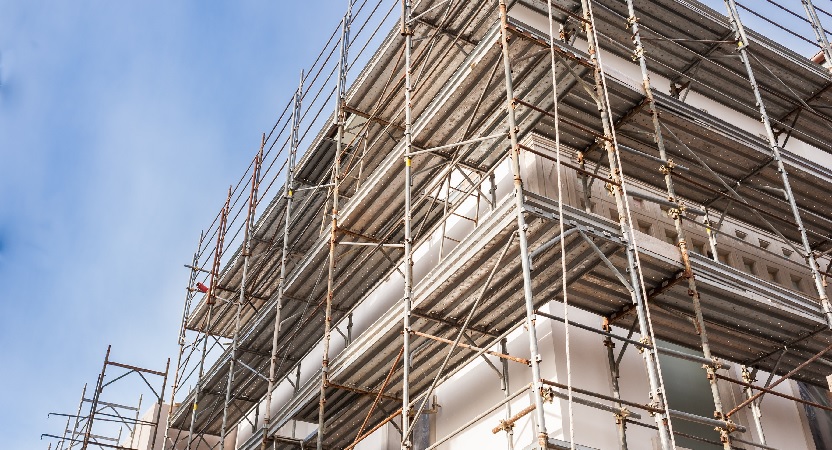Scaffolding is crucial in the construction industry, offering safety and efficiency during building projects. Companies like All Trade Scaffolding provide essential scaffolding solutions that ensure workers can perform their tasks at various heights securely and effectively.
While it may seem like just a temporary structure, scaffolding plays a vital role in the success of any construction work. This blog post’ll explore how scaffolding contributes to building efficiency and safety.
Types of Scaffolding
There are various types of scaffolding used in construction, each designed for specific tasks and project requirements:
Supported Scaffolding
Supported scaffolding is the most common type used on construction sites. It consists of one or more platforms supported by rigid, load-bearing legs. This type of scaffolding is highly versatile and can be used for various projects, from residential buildings to large commercial structures.
Suspended Scaffolding
Suspended scaffolding hangs from above using ropes or other non-rigid means, making it ideal for tasks like window washing, painting, or facade work on high-rise buildings. The flexibility of suspended scaffolding allows workers to adjust the height of their platforms as needed, providing them with precise access to different building areas.
Rolling Scaffolding
Rolling scaffolding is equipped with wheels, allowing it to be easily moved along the length of a building. This mobility makes it an excellent choice for projects that require frequent repositioning, such as large-scale painting or plastering jobs. The wheels can be locked in place to ensure stability while the scaffolding is in use and then unlocked for easy movement when needed.
Cantilever Scaffolding
Cantilever scaffolding is used when it is not possible to fix it to the ground. Instead, it is supported by a series of needles or brackets that are anchored to the building itself.
This scaffolding type is often used when ground access is restricted, such as overhanging structures or narrow alleys. Cantilever scaffolding provides workers a stable and secure platform, even in challenging environments.
Single and Double Scaffolding
Single or bricklayer scaffolding is commonly used in brick masonry work. It consists of a single row of vertical posts (standards) and horizontal supports (ledgers) that run parallel to the building wall.
On the other hand, double scaffolding is used for stone masonry work and involves two rows of standards placed at a distance from the wall to provide additional stability. Due to the weight and nature of the materials being used, double scaffolding is often used for projects that require extra support.
Enhancing Safety with Scaffolding
Safety is a top priority in the construction industry, and scaffolding plays a significant role in protecting workers from falls and other accidents. According to the Occupational Safety and Health Administration (OSHA), falls are one of the leading causes of fatal injuries in the construction industry. Properly designed and maintained scaffolding can significantly reduce the risk of falls and other accidents on construction sites.
Here’s how scaffolding enhances safety on construction sites:
Stable Work Platforms
Scaffolding provides a stable and secure platform for workers, allowing them to focus on their tasks without worrying about their footing. The platforms are typically made from wood or metal and designed to support the weight of the workers and their equipment.
Guardrails and Toe Boards
Modern scaffolding systems are equipped with guardrails and toe boards to prevent workers from accidentally stepping off the platform’s edge. Guardrails are typically installed around the perimeter of the platform to provide a physical barrier that prevents falls. Toe boards are placed along the edges of the platform to prevent tools and materials from falling off, which could pose a danger to workers below.
Compliance with Safety Standards
Scaffolding systems are designed to meet strict safety standards and regulations set by organisations like OSHA. These standards ensure that scaffolding can support both workers and the materials needed for the job. Regular inspections and maintenance of scaffolding also ensure that potential safety issues are addressed promptly. Companies like All Trade Scaffolding prioritise safety by ensuring their scaffolding systems meet or exceed industry standards.
Training and Supervision
Proper training and supervision are critical to ensuring the safe use of scaffolding on construction sites. Workers must be trained in the correct assembly, use, and disassembly of scaffolding and in the identification of potential hazards. Supervisors should oversee the use of scaffolding to ensure that workers follow safety protocols and that the scaffolding is used correctly.
Fall Arrest Systems
In addition to the safety features built into scaffolding, fall arrest systems are often used to provide workers an extra layer of protection. These systems include harnesses, lanyards, and anchor points designed to catch workers in the event of a fall. When used with scaffolding, fall arrest systems can significantly reduce the risk of severe injury or death from falls.
Boosting Efficiency with Scaffolding
In addition to enhancing safety, scaffolding also contributes to the efficiency of construction projects. Accessing different parts of a building quickly and safely can significantly improve the speed and accuracy of construction work. Here’s how scaffolding boosts efficiency on construction sites:
Access to All Areas
Scaffolding provides easy access to all building parts, including those that would otherwise be difficult to reach. This accessibility allows workers to complete tasks faster and more accurately, reducing project timelines and costs.
Organised Workflow
A well-planned scaffolding system can be customized to suit a project’s specific needs, ensuring that materials and tools are within easy reach. This organisation minimises downtime and ensures workers can move seamlessly from one task to another.
Time and Cost Savings
By providing a stable and secure platform, scaffolding reduces the need for workers to constantly adjust their position or rely on less efficient methods like ladders. This increased efficiency translates to significant time and cost savings for construction projects, allowing them to be completed on schedule and within budget.
Customization and Versatility
Scaffolding systems can be customised to fit the specific requirements of a project, whether it’s a small residential building or a large commercial structure. This versatility allows scaffolding to be used for a wide range of tasks, from simple repairs to complex construction projects.
Reducing Fatigue and Increasing Productivity
Scaffolding systems are designed to minimise worker fatigue by providing a stable and comfortable platform on which to work. Workers who are less tired can work more efficiently and with greater accuracy. The stability offered by scaffolding reduces the physical strain associated with working at heights, allowing workers to focus on their tasks without distraction. As a result, productivity is increased, and the quality of the work is improved.
Conclusion
Scaffolding is more than just a temporary structure; it is an essential tool that enhances safety and efficiency in construction projects. By providing stable work platforms, meeting safety standards, and improving access to all building areas, scaffolding ensures that construction work can be carried out safely and effectively. Whether it’s a minor renovation or a large-scale construction project, the role of scaffolding in achieving success cannot be overstated.
Also Read:- Discover the Luxury and History of Rolex 1908 Models – Timeless Elegance and Prestige



